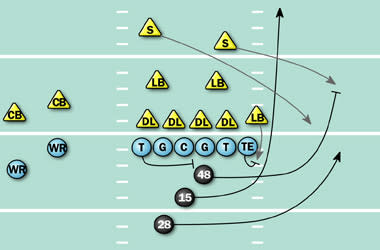Tebow can help cure red-zone woes
Also in this article:
Next Surveillance:
Cardinals
More NFL:
Editor's note: Yahoo! Sports will examine the biggest weakness of the 2009 season for every team and explain how the franchise can address the issue. The series continues with the Broncos, who finished second in the AFC West (8-8).
Biggest problem in 2009: These Broncos can't run in the red zone

Josh McDaniels could turn to a rookie QB in the red zone.
( Ron Chenoy/US Presswire)
Second-year head coach Josh McDaniels has jettisoned almost every offensive playmaker on the roster he inherited in January 2008. Jay Cutler(notes), Brandon Marshall(notes), Tony Scheffler(notes) … all gone. Coordinator Mike Nolan, who led one of the biggest single-season defensive improvements in NFL history for the team in 2009, left the franchise this past January after philosophical differences with McDaniels. Still, the team started 6-0 before collapsing down the stretch last season. There were several reasons for the late-season slide, but one problem that haunted the team all season long was the inability to get anything done with their run game in the red zone.
In 2009, the Broncos scored just nine rushing touchdowns, tied for 22nd in the league with the Lions and Bengals. That was down from 15 rushing scores in 2008. In addition, Denver ranked 21st in Football Outsiders' per-play efficiency metrics in red-zone rushing, and 26th in goal-to-go rushing. This after ranking second in red-zone rushing, and 14th in goal-to-rushing, in 2008. And this despite an offensive line that ranked sixth in FO's Adjusted Line Yards stat in 2009. That line will be without some key pieces in 2010: Left tackle Ryan Clady(notes) will miss a still-unknown amount of time with a torn patellar tendon, rookie Zane Beadles(notes) is projected to be the new left guard, and center Casey Wiegmann(notes) was released after McDaniels deemed him a poor fit for the new blocking schemes. Lead back Knowshon Moreno(notes) scored seven rushing touchdowns, but four of those came against the atrocious Chiefs defense, which further devalues Denver's red-zone power. However, the team did draft a real red-zone threat this year – a kid who set the SEC record for rushing touchdowns – and it might not be who you'd expect.
The 2010 solution: Tebow, option fullback

Figure 1
In 2009, University of Florida quarterback Tim Tebow ran for 14 touchdowns, five more than the entire Broncos team. And while McDaniels sees his new first-round quarterback as a future passer above all, getting creative close to the goal line would greatly benefit the team. Of Tebow's conference-record 57 rushing touchdowns (that's as many as running back Marshall Faulk had in three seasons for San Diego State), most came on designed rollouts or option plays, where even defenses trained to key on Tebow in goal-line packages were unable to stop him from scoring.
Two of those touchdowns came in Florida's 41-17 win over Georgia last Halloween, and the two plays – one in the red zone and one from outside – displayed Tebow's nose for the goal line in ways that could absolutely benefit the Broncos in the near future. With 1:39 left in the first half, the Gators had the ball at the Georgia 23-yard line. Tebow took the ball out of a shotgun set (Fig. 1) on third-and-3 and faked a handoff to halfback Jeffery Demps (2). The Bulldogs responded to the fake by biting on the run hard – both linebackers and both safeties in Georgia's nickel defense vacated the middle. Running back Marquis Hannah (48) helped seal the blocks inside, Tebow cut back inside with the ball behind Hannah's block, and blasted through the line for the 23-yard touchdown. McDaniels has expressed an interest in merging more multi-back sets with spread offense concepts, which makes Tebow a very good fit in plays like this; he's had years of practice in Urban Meyer's power spread.

Figure 2
The second Tebow touchdown came from the Georgia 5-yard line with 13:30 left in the third quarter. On first-and-goal, Tebow took the shotgun snap and headed right with running back Emmanuel Moody trailing in an option read look (Fig. 2). The concept here was simple: If the defense flowed to the outside to deal with the back, Tebow would take the play inside. If everyone pinched inside, Tebow would pitch the ball to Moody, who would run outside, (hopefully) unobstructed, into the end zone. In this case, Tebow saw a cutback lane around the safety who over-pursued to deal with Moody, and took the inside track for the touchdown.
These kinds of option reads have worked in the NFL before. When the 2004-2006 Falcons led the NFL in rushing with Michael Vick(notes), Warrick Dunn(notes), and T.J. Duckett(notes), Vick drove defenses crazy with them. Like Vick back then, Tebow has a lot to learn before he can make any wanes as a pure quarterback. However, that doesn't mean he can't help the Broncos in the short term, and that may have been what McDaniels was thinking then he took Tebow higher in the NFL draft (25th overall pick) than most people expected.
